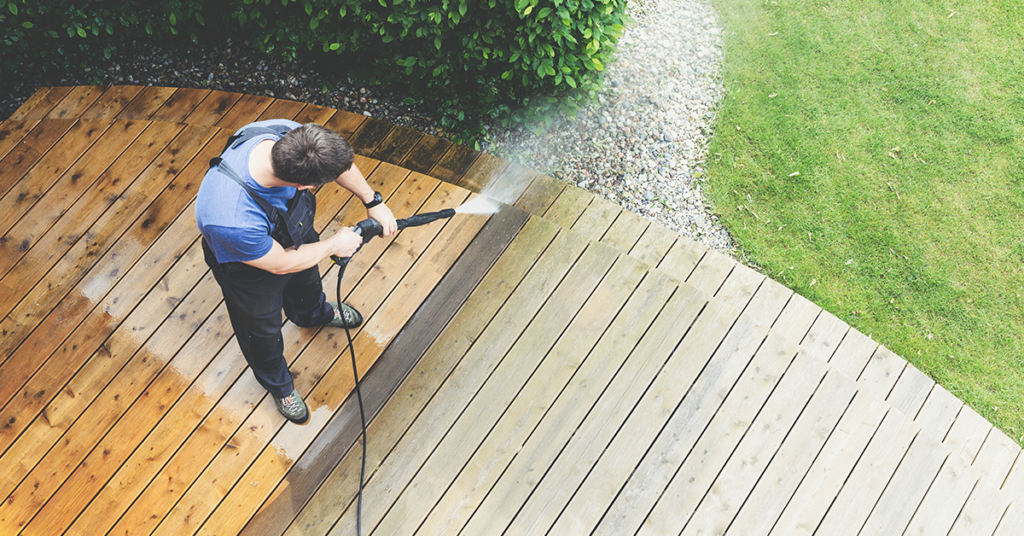Pressure washing is a popular and effective way to clean outdoor surfaces. In order to get the desired results, however, it is important to understand the basics of pressure washing and consider certain key factors.
This article will provide detailed information about surface preparation, selection of the right equipment, and methods for safe and efficient pressure washing. It will also discuss the importance of cleaning up and protecting surfaces after pressure washing. With this knowledge, readers can gain an understanding of how to properly use a pressure washer in order to achieve excellent results.
The process of pressure washing begins with an evaluation of the surface that needs cleaning. The type of material being washed must be taken into account when selecting a machine with enough power for proper cleaning without causing damage or wasting energy.
Additionally, it is important to prepare the surface before starting any work in order to prevent unnecessary wear on the equipment or injury from particles that may become airborne during cleaning.
After prepping the area, it is essential that users employ appropriate technique when operating a pressure washer in order to avoid damaging delicate materials or creating hazardous conditions due to improper handling.
Finally, once all work has been completed it is necessary to clean up thoroughly in order to rid any remaining debris and protect areas from further damage by applying sealants as needed.
Understand Your Surface
Determining the type of surface to be cleaned is an essential factor in the pressure washing process, as it will affect the pressure setting and the cleaning solution used.
Pressure washing can be applied to a variety of surfaces, such as concrete, wood decks, brick walls, and other porous surfaces. It is important for a homeowner or contractor to assess the surface before beginning any work in order to determine what type of water pressure should be used.
Additionally, different types of surfaces require different cleaning solutions. For example, some hardscapes may need special detergents that are designed specifically for those materials. Similarly, any wooden structures must be treated with care since they are prone to warping and splintering when exposed to too much water pressure.
It is also essential to consider other factors such as weather conditions and environment when undertaking a pressure washing project. If there are high winds during application or if you live in an area where rain is frequent during certain times of year then it may not be feasible to use a power washer on these days due to safety concerns or damage risks from wetting items that should remain dry.
Furthermore, some areas have ordinances related to water runoff which might necessitate extra caution when using pressurized water near drains or waterways. Lastly, it is important for homeowners and contractors alike to understand the importance of wearing protective gear while operating machinery like power washers since they can produce hazardous levels of noise and dust particles that could cause hearing loss over time without proper protection.
Taking all these factors into account before beginning any project will ensure successful results as well as safety for everyone involved. As such, it pays off in the end for homeowners and contractors alike who take their time assessing their surface types and environmental elements before starting any job involving pressure washing equipment – whether it’s residential or commercial in nature.
Choose the Right Pressure Washer
Selecting the appropriate power washer for a given task is essential for successful and efficient completion of the job; a pressure washer that is too powerful may cause damage, while one that is not powerful enough will be ineffective. The first step to finding the right pressure washer is to determine the correct pressure rating, as this will decide how quickly and effectively you can complete your task. A pressure rating between 1500-2000 psi (pounds per square inch) is usually sufficient for most jobs; however more intense tasks may require a higher psi rating.
The next factor to consider when choosing a pressure washer is nozzle selection. Different nozzles offer different spray patterns which are determined by their tip size and shape, allowing you to choose an ideal spray pattern according to your needs. Nozzles with narrow angle tips create a concentrated stream of water with high impact and are suitable for removing stubborn dirt from surfaces, while wider angles provide less impact but greater coverage area making them perfect for cleaning larger surfaces such as driveways or patios.
Finally, it’s important to bear in mind what type of detergent or cleaner you plan on using with your pressure washer. Certain types of cleaners require a certain type of nozzle or attachment in order to be used properly; make sure you get the right setup before beginning any cleaning job.
| Pressure Rating | Nozzle Selection | Detergents/Cleaners|
|—————-|—————–| ——————|
| 1500-2000psi | Narrow Angle | Appropriate Setup|
| Higher Ratings | Wider Angles | Specific Attachment|
Prepare the Surface
Preparation of the surface prior to pressure washing is essential for achieving the best results.
This includes clearing away any debris that might be present, as well as pre-treating any stains or spots that may be on the surface.
Taking care of these details beforehand will help ensure the most effective use of the pressure washer and optimal results.
Clear Away Debris
Removing debris prior to pressure washing is essential to ensure an effective and safe cleaning of the surface. Selecting the correct equipment for clearing away debris is critical, as some surfaces may require different tools than others.
It is important to consider safety precautions as well, such as wearing protective gear like goggles and gloves.
Here are four key factors to consider when clearing away debris:
* Properly selecting the appropriate equipment for the task
* Taking necessary safety precautions
* Removing large objects manually before power washing
* Making sure all areas are cleared of any loose items
Pre-Treat Stains and Spots
Applying a pre-treatment solution to stains and spots can be an effective way to increase the efficacy of pressure washing. According to research, pre-treating areas with particularly stubborn dirt or grime can reduce cleaning time by up to 75%. Choosing the right chemical solutions and detergent choices is key when selecting a pre-treatment solution for pressure washing.
|Chemical Solutions | Detergent Choices | Benefits |
| :—————-:| :—————:| ——–:|
| Bleach | Powder soap | Cleanser |
| Vinegar | Liquid Soap | Degreaser|
| Sodium Hydroxide | Specialty Soaps | Sanitizer|
| Acids | Baking Soda | Disinfectant ||
Using chemical solutions and detergents in combination with hot water can create a powerful cleaning agent that will loosen dirt, debris, oil, grease, mold, mildew and other unwanted substances from the surface being treated. The specific chemical solution used in conjunction with the appropriate detergent will depend on the type of stain or spot being treated. It is important to select the right combination of chemicals and detergents for optimal results when cleaning surfaces with a pressure washer.
Use the Right Technique
When considering pressure washing, it is important to use the correct technique for optimal results. Safety gear should be worn at all times when using a pressure washer, such as gloves, eye protection and non-slip shoes.
In addition, familiarizing yourself with different nozzle types can help you choose the one that best suits your needs. Nozzles come in various sizes and angles from 0 degrees (which is the most concentrated blast of water) to 40 or even 65 degrees (which provides a much wider spray pattern). Depending on what material is being cleaned will determine which type of nozzle should be used.
For example, concrete surfaces require more intense cleaning and therefore require a smaller degree nozzle size like 0 or 15 degrees. On the other hand, larger surfaces such as decks usually need less powerful nozzles such as 25 or 40 degrees to avoid damaging them with too much force.
It is also important to keep in mind that pressure washing requires certain distance between the surface being washed and the washer itself; otherwise it can cause disfigurement or other damage due to overpressure. Therefore, the user must always make sure they are using their equipment at safe distances from any surface they intend to clean.
Additionally, if working with hot water instead of cold water it is advised that protective clothing be worn in order not to get burned by steam created by hot water contact with cool surfaces like walls or floors.
Pressure washing can be very beneficial when done correctly but it can also cause significant damage if done improperly so paying attention to safety measures and taking time to learn about different nozzles types are key factors for successful results when undertaking this task.
Clean Up and Protect
Once the pressure washing is complete, it is essential to take steps to ensure that the area is properly cleaned up and protected.
Firstly, all surfaces must be carefully examined for any remaining dirt or debris that may have been left behind from the pressure washing process.
Secondly, any protective covers or guards should be put back in place as soon as possible in order to protect previously washed surfaces.
Finally, all equipment used during pressure washing must be maintained regularly according to manufacturer guidelines in order to ensure its optimal performance and longevity.
When it comes to protecting surfaces after a pressure wash, it is important to check for any residual dirt or debris that could lead to staining or discoloration if left unchecked.
This includes inspecting windowsills, porches, decks and other areas that may have been missed during the initial cleaning process.
Additionally, while re-installing protective covers or shields on vulnerable surfaces such as fences and railings, make sure they are securely fastened so there won’t be any potential damage due to windy conditions.
Finally, proper maintenance of pressure washing equipment can go a long way towards ensuring its optimal performance and longevity over time.
This means keeping all nozzles clean of dirt and grime buildup by periodically soaking them in hot water with dish soap added; checking hoses for wear-and-tear before each use; replacing worn down o-rings; using only compatible detergents; storing machines correctly when not in use; lubricating moving parts such as pistons; properly draining tanks after each use; inspecting motor brushes for signs of wear etc – these small but important steps will help keep your machine running smoothly for many years ahead.
Conclusion
Pressure washing is a powerful tool for keeping surfaces clean. The key to using it effectively lies in understanding the surface, selecting the right pressure washer and technique, and taking the time to properly prepare and protect the surface after use.
When done correctly, pressure washing can provide long-lasting results that will make any space look brighter and refreshed. It is an effective way to keep outdoor features looking their best while making indoor spaces appear as if they were recently remodeled.
Pressure washing is a great choice for anyone looking for an efficient and cost-effective way to maintain their property’s appearance.




